Google 5 different queries, and you’ll see different types of search results for each one. Google the same query on 5 different days, and you may also see different rich results each time.
Why are there so many different types of search results available depending on the query? Google uses a myriad of rich snippets on the SERP to show you information in the way they think makes the most sense, based on search intent.
By tracking which rich results Google shows for their top keywords, SEOs can find out what their target page 1 looks like, and learn more about the intent of its searchers along the way.
This list includes the 13 types of search results that Google is most likely to show you, how to optimize for them, and what to know about them in 2020—the new features, the drama, and the ways you can gain customer insights. In fact, you’re able to track all of them using the Traject Data SEO API.
Table of Contents
Organic “Blue Link” Results
These are the traditional search results that Google has been serving up on the SERP since its inception. It’s composed of a blue linked headline (the web page title), with the url in smaller text above it and a short description below.

The description shown is called a metadescription, and it gives users a small preview of what they’ll find on that page. Webmasters should always edit the metadescription to achieve conversions and give that succinct preview, otherwise Google will automatically decide the text they pull for this section.
How to optimize for it
This is a can of worms, as this is what the entire practice of SEO is built around. At the most fundamental level, you should work to improve three areas of performance to rank in these organic results.
1. Technical SEO
This includes maintaining your site so that Google’s bots can effectively crawl it and optimizing UX factors that will earn a higher rank, like page speed.
2. On-page SEO
This is the content of your website, written to provide valuable answers to user queries.
3. Off-page SEO
This is instances of your site or content on other sites, such as reviews, that signal to Google that you are a trusted authority, like earning backlinks to your site in news articles.
What you need to know about these results in 2020
“Position 1” of the blue link texts used to be the most coveted achievement of all SEOs, because it earned you the highest visibility in the SERP.
These days, the first organic blue link result is usually below the fold, and requires some scrolling to reach it. It will be deprioritized underneath featured snippets, other visual search features, anything hosted on a Google-owned platform, and 1-4 ads.
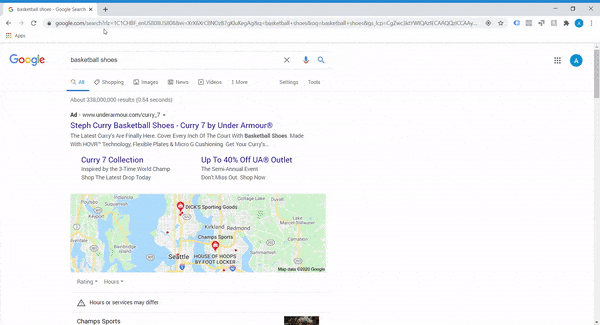
Paid Ads
Paid ads follow the same format as organic results, with the addition of the text “Ad” before the URL to let the searcher know that a business paid to win that spot. Depending on the query, a searcher can see up to 4 ads on page 1 of search results, usually concentrated at the top.

Search engine marketing (SEM) is often seen as an entirely different field than SEO, and it’s true that there are many disparate tasks and strategies. However, SEOs should be cognizant of the insights they can pull from overlapping efforts or from Keyword Planner as they perform their keyword research.
How to optimize for it
Google explains that ads are ordered based on a combination of cost-per-click (CPC) bid and relevance. To learn more about Google Ads and search engine marketing, you can take the course provided by Google and earn a certification when you complete the following exam.
What you need to know about these results in 2020
Ads continue to live at the top of the SERP and can push the first organic result down to the bottom half of page 1 after all ads and features are said and done.
The biggest beef that SEOs have with Google Ads is that it can prevent a business with a lot of brand recognition from appearing first for even a branded search unless that business also coughs up the cash to buy those ad spots.
Let’s say you own a shop called the Pike Place Florist, and you’ve spent years building up brand recognition among Seattlites. When someone searches for the exact term “Pike Place Florist” you’ll most likely be the first organic result.
However, if you’ve decided not to purchase Google Ads for your flower shop, a handful of your competitors who have specifically bid on the keyword “Pike Place Flowers” will show up first, stealing the brand equity you’ve earned.
Is there a way around this? Not yet, and advertising revenues accounted for $134.8 billion of Google’s 2019 revenue, so it isn’t very likely. Because you’ll be most likely to appear for ads in branded searches, you could always just start with a very modest budget to keep competitors at bay.
If you really aren’t looking to spend any money, investigate how you can rank for featured snippets to up your visibility that way instead.
Local 3 Pack
the Local 3 Pack is a highly visual listing attached to a map that presents searchers with the 3 businesses Google considers to be:
- Most convenient to the searcher’s location
- Most relevant to the query
- The highest quality business
This feature appears when Google assesses that the query has “local intent,” meaning that the keyword is consistent with searches in the “Go” category of the 3 ways Google splits up types of search intent: “Know, Go, and Do.”
Google determines that when I search “dentist” I am most likely looking to “go” to a dentist, cross references that with my location data, and then serves me a Local 3 Pack at the top of the SERP.

How to optimize for it
Ranking for the Local 3 Pack requires a different strategy than winning a top organic search results, because the pack will pull results based on your Google My Business listing, not necessarily content just on your website.
You’ll notice that the first few organic search results in this example aren’t local businesses, but instead listing sites or blogs assessing the category in the query. This is usually the case, and all the more reason to prioritize optimizing your Google My Business—otherwise a ranking spot will be hard to earn.
To give yourself the best chance of ranking for this feature, get familiar with the value of a complete GMB. It should be accurate, consistent with other listings, loaded with a large quantity of online reviews with a great rating, and designated with the categories and attributes that make sense for your business.
What you need to know about these results in 2020
Google My Business has released several new COVID-related features that will help users easily tell if you’re offering accommodations or differing hours. Many of these show up prominently in the local pack (and sometimes the Knowledge Panel), so it’s worth going through the list of new features and optimizing all the ones that fit your business.
In an additional show of support for small businesses, Google has added “support links” and highlighted them in search features. These links will allow users to buy gift cards or contribute donations to businesses they want to support but are unable to patron right now.
Knowledge Graph and Knowledge Panel
The Knowledge Panel refers to the panel on the right side that gives a fairly holistic view of the subject you just searched for if it’s a single known entity, like a historical figure, a business, or a move. It pulls in facts from a variety of other sources, but this panel is Google’s method of presenting all of those sources in a visually organized way.

To square away our terminology, the Knowledge Panel is the search feature you see, while the Knowledge Graph refers to the mechanism that pulls this information from various sources. The types of links and sources differ between queries. For example, a person may have links to a Wikipedia article, while a new movie may have links to purchase tickets.
How to optimize for it
You can “optimize” in a few different ways when discussing Knowledge Panels:
- Use schema markup on your content to help Google understand the type of entity that your business entails.
- Rank your informational content on a knowledge panel as one of the links.
- Optimizing a knowledge panel about your own business or yourself.
If you’re attempting to become one of the links pulled in by the Knowledge Graph, you must be the highest authority on the subject. Write excellent content on the facts and figures shown in the Knowledge Panel you’re targeting, including concise answers that use the same terminology as the data points in the Panel to make it crystal clear for Google.
If you’re looking to optimize a Knowledge Panel on yourself or your business, you can claim a Knowledge Panel by clicking that option underneath it on the SERP. This will give you a degree of control on the information and help ensure that your sites win the links, not the sites about you that are just optimized better.
What you need to know about these results in 2020
The links in the Knowledge panel have become much more interactive over the last couple years, and this is thanks to Google’s increasing understanding of intent. Search for Starbucks and you’ll be able to click on menu items and see nutritional info. Search for American Airlines and you’ll have a space to enter a flight number for tracking.
Because these interactive features vary so much, make sure you’re tracking which Knowledge Panel attributes are available for the Panels associated with your top keywords.
Image Pack
The image pack shows when Google assesses that visual content would be valuable to the query. It shows the same first handful of images that would rank at the top if you were to perform a search specifically in Google images, and when you click on an image in the pack, that’s where it takes you (not to the host site).

How to optimize for it
These are the components you should specifically label or edit to be relevant to the content of the image
- The image file name
- The alt attribute on the image
- The image caption
- Surrounding text content
- The page title
- The page URL that it’s hosted on and the URL’s relevance to the image content (Meaning that 1 or 2 specific images is relevant to the topic on the web page)
- Image size and dimensions (not too big, not too small, not weird abnormal shapes)
What you need to know about these results in 2020
Google’s visual processing initiative, a product called Google Lens, is reaching a high enough level of sophistication that it can often tell what is in the image without these attributes.
It identifies image attributes using visual analysis based on a neural network, so don’t make the mistake of trying to outsmart the engine by optimizing the other factors to say the image is something that it isn’t.
Video Pack
The video pack is a card-style feature that shows several links to videos relevant to the query. When the video pack was first implemented, it usually only appeared when the query named specific intent to watch a video, but now it increasingly shows relevant video content for a wide range of query types.
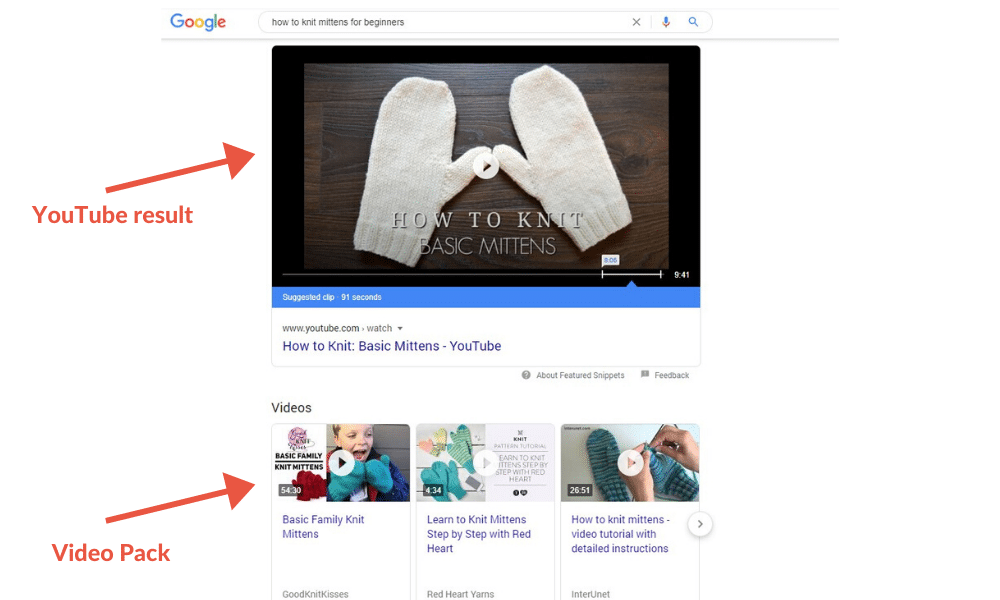
How to optimize for it
YouTube videos will get preference on these search features, so if you aren’t hosting your videos on YouTube, it’s time to start a channel and then begin optimizing from there.
Use keyword research and suggested searches in the YouTube query bar to help understand what people are searching for and pick your topics and the best title for your videos. This will help guide your content strategy moving forward, but it should also show you opportunities to update old video titles and descriptions.
One of the top YouTube ranking metrics is watch time. If you aren’t already a pro, use a video editing software like Camtasia to help you make the video look professional. Once you have the resources to make it look polished, it will simply be a matter of filling it with highly engaging content, and making it relevant to the title and thumbnail you presented in the search results.
What you need to know about these results in 2020
Not exactly breaking news in 2020, but Google continues to draw the ire of SEOs and searchers for prioritizing YouTube videos above all other video results, even if other video results are more relevant. Sometimes a single YouTube video will be shown as the first result instead of the card-style video pack, which then follows further down the SERP.
Google purchased YouTube back in 2006 and has since awarded content on the platform with generally higher rankings. While the bias within video results is clear, it’s unclear whether they choose to show video packs for more types of search intent than they would if it didn’t afford them the opportunity to drive traffic to YouTube.
Featured Snippet
Featured snippets pull a piece of content from a web page in order to provide a quick (sometimes zero click) answer to a query. They are most often shown in response to longtail, question-form queries, and will populate in 1 of 3 forms:
- Paragraph
- List (numbered or un-numbered)
- Table
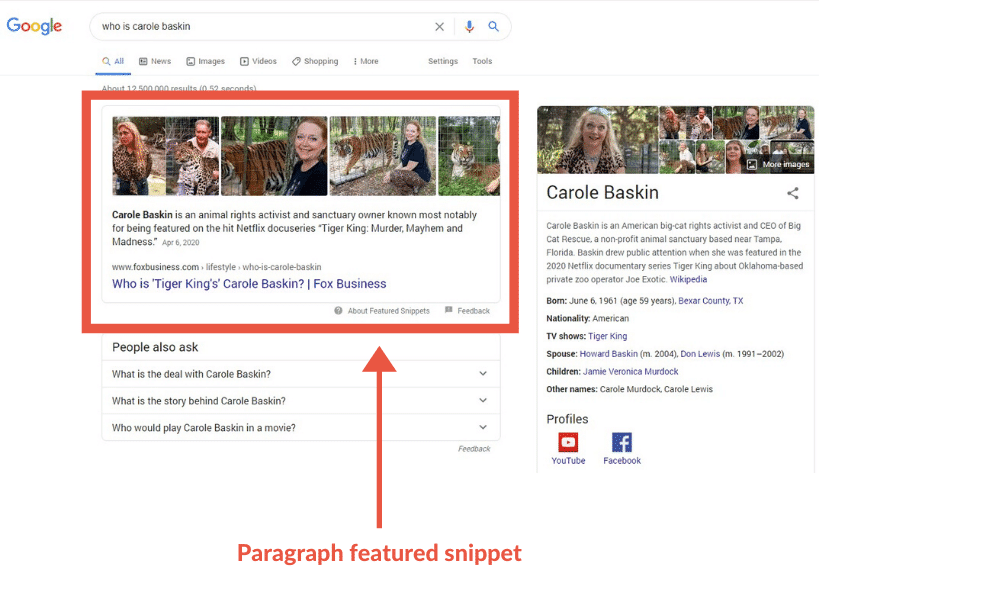
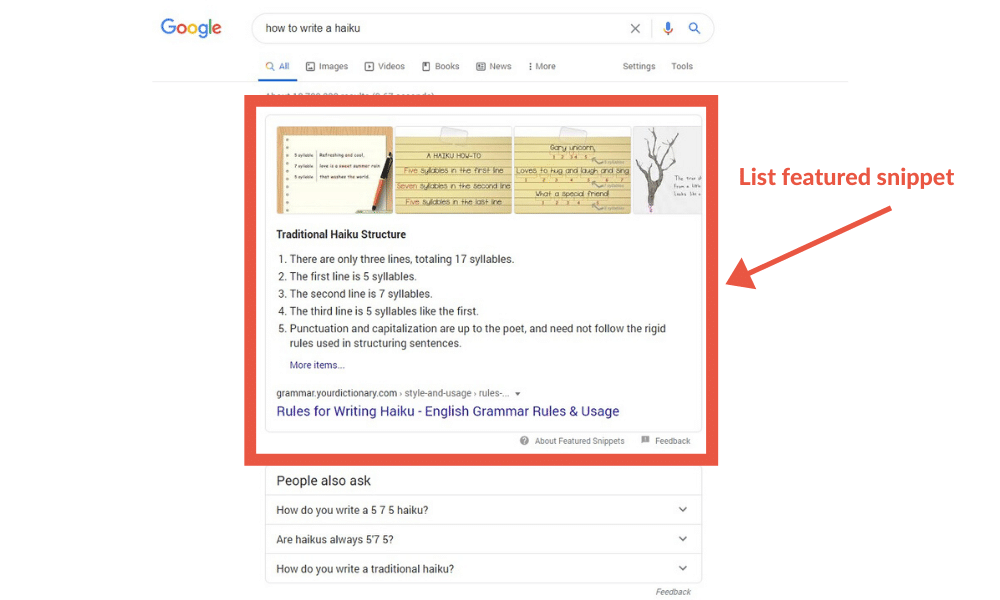
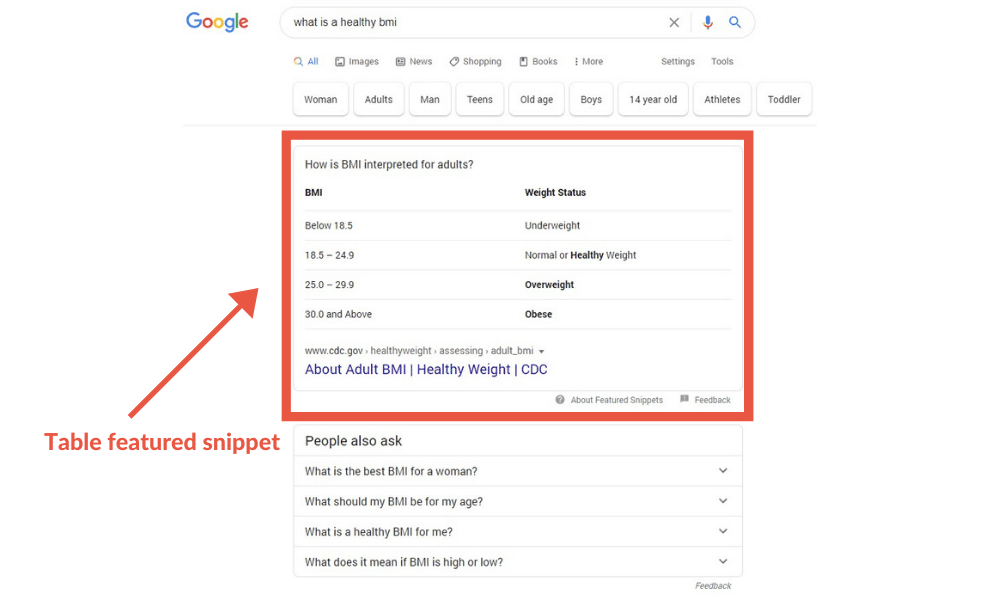
How to optimize for it
Optimize for featured snippets by following these steps. For more actionable instructions on how to carry out each step, use our guide to featured snippets.
- Featured snippets are drawn from the top 10 results, so work on your SEO factors to accomplish this first
- Identify your best keyword opportunities
- Discover relevant longtail questions
- Match the format of the content you create to that which shows up for the query you’re targeting
- Answer questions concisely
What you need to know about these results in 2020
Google made an algorithm update that prevented “double dipping” in the SERPs, meaning that web pages that ranked in featured snippets could not appear in the organic blue link results on page 1.
Almost all featured snippet holders were the top 10 organic results, and many featured snippet holders also held the number one, so this was a significant change for everyone that competes for featured snippets.
This means SEOs have a decision to make: Do you get higher, more qualified traffic from holding a blue link or a featured snippet? Every business needs to test this for themselves to find the right solution, because it can vary widely across different situations.
Sitelinks
Google says, “The links shown below some of Google’s search results, called sitelinks, are meant to help users navigate your site. Our systems analyze the link structure of your site to find shortcuts that will save users time and allow them to quickly find the information they’re looking for.”
Essentially, if there’s a page that users are very likely to navigate to once they click on your organic result, like a pricing page, Google will give them a shortcut directly on the SERP.

How to optimize for it
To optimize for sitelinks, Google recommends that you perform upkeep on your site’s internal links, and make sure you use anchor text and alt text that’s informative, compact, and avoids repetition.
If there is a topic that you know most customers will go straight to when they search for your site, structure your site so it will have it’s own page and title tags—don’t make them hunt for it.
What you need to know about these results in 2020
At this point in time, selecting sitelinks for the SERP is still an automated process at Google. Manual webmaster input isn’t possible yet, meaning there isn’t any way to present a sitelink to Google that you believe would be helpful for searchers.
However, Google does note on their site that they are always improving the algorithm to find helpful sitelinks, and that webmaster input may be implemented in the future.
Shopping Pack
When Google recognizes the search intent of a query as transactional, or intending to buy something, it will often surface the shopping pack: a feature with 3 more cards that show an image of a product and link to an eCommerce site where you can purchase it. For some queries, the shopping pack is now being shown in the right-side panel.

How to optimize for it
Appearing in the shopping pack is part of participating in the Google Merchant Center, which is why you’ll see the word “sponsored” included here. Google recommends optimizing for the shopping pack in 4 different ways, and you can read more actionable tips for each of these on their Google Merchant Center Help site.
1. Think strategically about your customers
This includes thinking through the customer journey and the UX of how they will find products or product categories and complete a purchase.
2. Highlight important product details
This includes optimizing product titles and including relevant categorical information in your title tags.
3. Use high quality images
This refers to both the resolution of the photo as well as content, like clearly showing the product against a contrasting background or deleting promotional graphics on the image.
4. Provide your most accurate product data
Stay current with pricing, inventory, and all other attributes on your products. Accurate product data can also refer to having unique product IDs for each item and selecting the most relevant product categories.
What you need to know about these results in 2020
To respond to the hardships faced by retail businesses during COVID-19, Google has announced that they will make Shopping listings free on both the Shopping vertical as well as in the organic results.
This is good news for smaller retailers who now have the opportunity to rank without spending advertising dollars, but they should take it with a grain of salt—site authority is still a huge ranking factor for organic results, and it may be incredibly difficult for a mom and pop to oust Target.
News Pack
The news pack is a card-style feature that was recently renamed to “Top Stories” that presents more timely, informational updates usually published by specified news outlets.

How to optimize for it
The effectiveness of schema markup is hotly debated in the SEO community, but this is one category where Google specifically recommends using markup to let crawlers know that your page is a timely news story.
According to Search for Developers, “Adding structured data to your news, blog, and sports article page can enhance your appearance in Google Search results.” You can find a tutorial on how to implement it on Google’s site.
Does this mean anyone can rank for Top Stories? Though a wide variety of sources have the potential to be pulled into Top Stories, it does still tend to favor larger, more distinguished news outlets. You can still attempt it by following SEO best practices and finding current or lesser-covered news stories to break.
Pro-tip: Changing world events will in turn change the search features Google presents in order to match search intent. A search for Australia one day may turn up a map and a historical summary, then the next day show “top stories” as wildfires break out. Keep this in mind as you track opportunities to rank for this feature.
What you need to know about these results in 2020
In order to mitigate recent criticism on how they choose or compensate publishers, Google released a statement on their goals for supporting fair and accessible journalism.
Included in the statement were assertions that they uplift publishers rather than “walling them off.” Says Google, “Every month we send Google users to news sites 24 billion times, providing an opportunity for publishers to grow their audiences and show Google’s users ads or offers for subscriptions.”
They also included recommendations on how publishers can control the way they’re pages are shown in results and features, claiming that they put publishers “in the driver’s seat.”
Perhaps most noteworthy, they’ve decided to start paying publishers for their content. Google announced a new licensing program to pay for content for a news product launching later this year, including paying for free access to paywalled articles. So far this is signed with publishers in Germany, Australia and Brazil,and they say they’re in talks with more publishers and countries.
Jobs Pack
When searching for anything related to employment positions, Google will most likely surface the “Jobs” pack. This shows 3 top job results and several filters you can leverage.
Clicking any of the links in the Google Jobs pack launches Google Jobs Search which can provide hundreds of results on the left pane and the full job listing on the right.

How to optimize for it
This is a case where Google says that it’s helpful to implement Jobs markup structured data, and gives specific directions on how to do so on their site.
Google also advises that you can skip the need to add structured data to postings on your site by integrating with a third party job posting platform. Google works with listing sites like Ziprecruiter, and says that they earned a 4.5x higher Google organic conversion rate than they previously had before integrating with Google Jobs.
You can also optimize your job postings for the Jobs pack by mimicking the terminology Google uses for filters in your job listing, and being sure to answer every single one that’s relevant to the position.
What you need to know about these results in 2020
Google says that due to COVID-19, they’ve seen more job seeker interest in work-from-home and remote job opportunities. They created structured data to distinguish these positions and encourage job posters to mark up their work from home jobs.
People Also Ask
People Also Ask is a feature in the form of a dropdown menu of questions related to the original query. Searchers can click on the question that most accurately drills down into the information they want to know, and they’re then presented with a featured snippet that won that question.
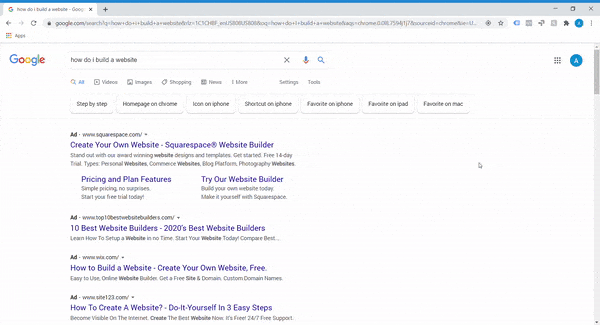
SEOs can think of this as a sort of backdoor way for more chances as page 1—instead of the normal 10 organic results or 1 featured snippet that normally appears, you can appear for various questions in the People Also Ask feature.
How to optimize for it
Optimize for these in the same way you would for featured snippets: Use a question and answer based approach for choosing the topic, and answer questions concisely. After that, use an organized structure and headings so that Google can tell which items they should truncate into a bulleted list, for example.
What you need to know about these results in 2020
This is a great tool for informing your content strategy and your featured snippet strategy.
If you enter a query related to your business, this feature is literally spoonfeeding you data on the other queries being asked by the same searchers who just entered that keyword. If you rank on page 1 for a query, it’s because you’re an authority on that topic—you’re likely also an authority on the related topics in People Also Ask.
Track which questions are appearing in this feature for keywords you’re ranking for, because if you don’t have content to answer those questions as well, you’re giving up easy wins to competitors.
Related Searches
This is 8 additional links that populate new Google searches and appear at the bottom of the SERP. It aims to guess the user’s next logical question as they look for information within a topic.
Related searches may be the feature that gives you the most information about the search intent of users. If they start out on a keyword for a broad topic, Google will show which questions they’re likely to want to know next, and if those questions fall in the “know” “go” or “do” search intent category.

How to optimize for it
These links bring the user to an entirely new Google search for that query, featuring all the ads, organic results, and other search features Google would normally show for that query. Optimize for these new longtail keywords using the same SEO fundamentals you would for any other organic results.
Influencing these results is possible, if you invest the time and resources into changing how people think about a topic or spur them onto specific questions about your brand. The best way to do this is either to produce a lot of high quality content, or invest in a reputation management strategy.
What you need to know about these results in 2020
Use these questions to get familiar with the intent of searchers in your industry and to plan your future content.
For top of funnel content, track which related questions come up in this feature when a user enters one of your most fundamental keywords. For branded searches, drill down into what potential customers specifically need to know from your business.
Getting familiar with which related searches are shown for the top keywords you track can shed light on where your customers are going next and what they want to know.
Final Thoughts on the Different Types of Search Results You Need to Know About
The types of search results that Google decides to show for queries—whether it be videos, a list, or a map—can give SEOs huge clues about what types of answers searchers want, and what they intend to do with that information.
Sure, the point of becoming familiar with these types of search results is to find out which of these features appear for your business’s top keywords and optimize your web pages to win them.
Take it step further and use what you learned about your customers’ intent to inform your content plan, the types of questions you’ll answer, and the format you’ll create it in to perfectly align your web site with those users.


